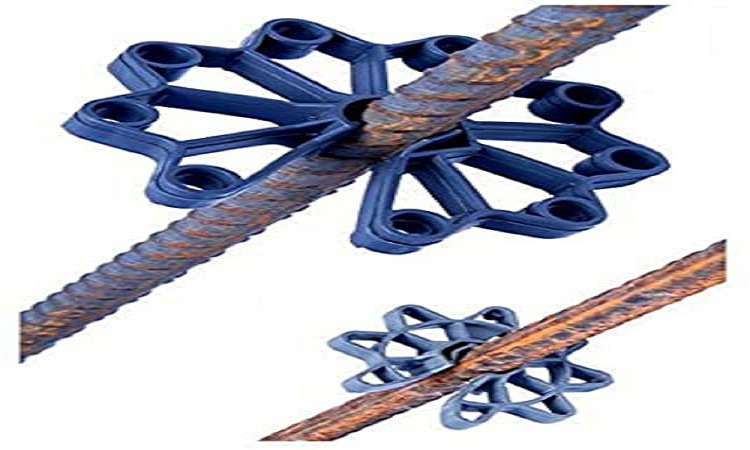Cover blocks or spacers are divided based on the materials utilized in their manufacturing process.
These are given below for various spacers:
- Metal Spacers
- Plastic Spacers
- Concrete Block Spacers
- Wood Spacers
Metal Spacers
Metal spacers are commonly used and are interchangeable with slab bar supports. They provide good anchorage or bond to concrete, are easy to attach, and do not cause cracks in the concrete due to elevated temperatures since the coefficient of thermal expansion is very similar to that of concrete. They must be wired or tied to the reinforcement. If support legs made of regular steel are not plastic-protected, rust marks can appear.
Stainless steel support legs can be used in RC slabs, when reinforcement is provided at the top and bottom, chairs should be provided so that they are kept at the required distance. If these chairs are not provided, the reinforcement bars may be bent or get distorted due to the movement o men during concreting. These chairs also maintain the top cover for the top reinforcement they should be placed at sufficient intervals. In India, such chairs are very rarely provided, leading to decreased strength of reinforced concrete elements particularly when the rods are cranked.
Plastic Spacers
Many sizes and types of plastic spacers are readily available. Economical, easy to use, non-corrosive, and usually inconspicuous, these are available in several colors to closely match the color of concrete (Gray, white and warm tone). They generally snap onto the reinforcing bar and need not be tied. The shape must be properly designed and should be produced using plastic of good quality. Elevated temperatures could cause differential expansion and possible cracking of the concrete.
Concrete Block Spacers
Concrete block spacers can easily be made at the job site, and are best used when reinforcing bar must be isolated from galvanic action. The color may not match that of the surrounding concrete. If not of high quality, the block can absorb water and lead to corrosion of the reinforcing bar.

Wood Spacers
Wood spacers are inexpensive and easily made at the job site. The wedge type can be adjustable for spacing variations. Wood spacers must be removed; otherwise, they are unsightly and undesirable. They are sometimes difficult to position and remove, especially at mid-height of a column form or wall form.
Quality of Cover Devices/Spacers
It is often observed that cover devices, specially made out of cement mortar or concrete, in our country, are of extremely poor or low quality. They are most often manufactured at the site. Hand-mixed mortar is hand-compacted without any control over water-cement ratio (W/C), or without assuring the correct grade of concrete. Cover blocks are also not completely compacted and sufficiently cured. Persons responsible for their manufacture are selected from the workers who are not capable of any other type of hard laborious work. Thus, cover devices are permeable and full of voids and easily allow moisture and other chemicals to attack the steel to which they are generally fixed.
The cover devices should be such that they have the same strength and W/C, as that of the main concrete member. The cover devices should also be dense. The cover devices should be strong enough to take the load, which gets transferred on them during concreting, and should be of the correct size so as to maintain the steel reinforcement away from the exposed surfaces of concrete.
Cover devices are required to maintain the reinforcing bar in the correct location, both in the horizontal and vertical directions. The cover devices should be capable to give reinforced concrete and reinforcement inside it provides a good structural bond, good appearance of finished concrete, fire resistance, and good corrosion resistance or durability.
Optimum Cover Thickness
It is always a debatable issue while trying to decide on an optimum cover. If the cover is not thick enough, protection to reinforcement may not be effective and if the cover is very thick, it will lead to increased crack widths that exceed the maximum limits permitted by standards.
However, it is observed that when the cover thickness is greater than 50 mm, the crack widths increase to more than those specified in the various standards. Makhlouf and Malhas observed in their studies, that if the spacing (S) of wide cracks are less than twice cover thickness (C) i.e. S < 2C, then there will be a reduction in the effectiveness of thick cover in protecting the steel bars against corrosion.
Streit & others studied the influence of an increased concrete cover on the transverse tensile stress when the cover with and without inclined reinforcement is subjected to positive bending moments. Their studies also showed that thick cover leads to the substantial increase of the transverse tensile stresses in concrete and a subsequent decrease of failure moment compared to members with a smaller concrete cover.
Therefore, just increasing the cover does not necessarily increase the durability of concrete as seen above, and this needs to be examined in greater detail.



